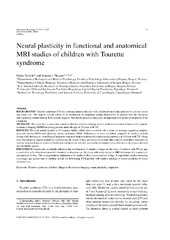| dc.contributor.author | Eichele, Heike | |
| dc.contributor.author | Plessen, Kerstin J. | |
| dc.date.accessioned | 2016-07-29T08:29:40Z | |
| dc.date.available | 2016-07-29T08:29:40Z | |
| dc.date.issued | 2013 | |
| dc.Published | Behavioural Neurology 2013, 27(1):33-45 | eng |
| dc.identifier.issn | 0953-4180 | |
| dc.identifier.uri | https://hdl.handle.net/1956/12350 | |
| dc.description.abstract | Background: Tourette syndrome (TS) is a neuropsychiatric disorder with childhood onset characterized by chronic motor and vocal tics. The typical clinical course of an attenuation of symptoms during adolescence in parallel with the emerging self-regulatory control during development suggests that plastic processes may play an important role in the development of tic symptoms. Methods: We conducted a systematic search to identify existing imaging studies (both anatomical and functional magnetic resonance imaging [fMRI]) in young persons under the age of 19 years with TS. Results: The final search resulted in 13 original studies, which were reviewed with a focus on findings suggesting adaptive processes (using fMRI) and plasticity (using anatomical MRI). Differences in brain activation compared to healthy controls during tasks that require overriding of prepotent responses help to understand compensatory pathways in children with TS. Along with alterations in regions putatively representing the origin of tics, deviations in several other regions most likely represent an activity-dependent neural plasticity that help to modulate tic severity, such as the prefrontal cortex, but also in the corpus callosum and the limbic system. Discussion: Factors that potentially influence the development of adaptive changes in the brain of children with TS are age, comorbidity with other developmental disorders, medication use, IQ along with study-design or MRI techniques for acquisition, and analysis of data. The most prominent limitation of all studies is their cross-sectional design. Longitudinal studies extending to younger age groups and to children at risk for developing TS hopefully will confirm findings of neural plasticity in future investigations. | en_US |
| dc.language.iso | eng | eng |
| dc.publisher | Hindawi | |
| dc.publisher | IOS Press | eng |
| dc.relation.ispartof | <a href="http://hdl.handle.net/1956/16425" target="_blank">Electrophysiological Correlates of Performance Monitoring in Children with Tourette Syndrome. A developmental perspective</a> | |
| dc.rights | Attribution CC BY | eng |
| dc.rights.uri | http://creativecommons.org/licenses/by/3.0/ | eng |
| dc.subject | Tourette syndrome | eng |
| dc.subject | children | eng |
| dc.subject | Magnetic Resonance Imaging | eng |
| dc.subject | neural plasticity | eng |
| dc.subject | adaptation | eng |
| dc.title | Neural plasticity in functional and anatomical MRI studies of children with Tourette syndrome | eng |
| dc.type | Peer reviewed | |
| dc.type | Journal article | |
| dc.date.updated | 2016-04-07T12:16:00Z | |
| dc.description.version | publishedVersion | |
| dc.rights.holder | Copyright 2013 Hindawi Publishing Corporation | eng |
| dc.identifier.doi | https://doi.org/10.3233/ben-120294 | |
| dc.identifier.cristin | 1039677 | |
| dc.subject.nsi | VDP::Samfunnsvitenskap: 200::Psykologi: 260::Biologisk psykologi: 261 | |
| dc.subject.nsi | VDP::Social sciences: 200::Psychology: 260::Biological psychology: 261 | |

